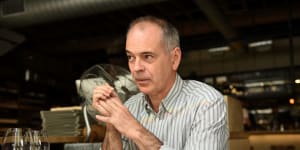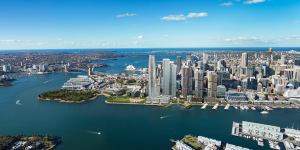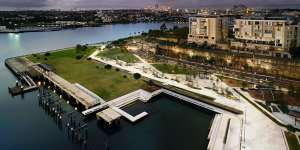Philip Thalis has barely sat down when the news comes through. Minutes before our scheduled lunch,Judge Robson of the Land and Environment Court hada community challenge to Crown's casino and apartment complex at Barangaroo.

"We don't just have to accept poor projects as the normal practice":Philip Thalis.Steven Siewert
Thalis has thought more than most,or perhaps more than all,about Barangaroo. A decade or so ago,his team won an international competition to design what should one day emerge at the western edge of Sydney's central business district.
Thalis'team won the Barangaroo competition for the same reason so many have since attempted to resist Crown's casino there:the base of the casino will sit on and block a publicly owned foreshore that Thalis'designs had reserved for public use.

The base of the proposed casino at Barangaroo will block the publicly owned foreshore Philip Thalis' designs had reserved for public use.
"The defining characteristic of our scheme was that the whole foreshore was inalienable public land,"says Thalis."That's why the jury said we won unanimously out of 137 schemes."
"We had worked up and down the harbour in Sydney. We knew what the privatisation pressure was. We knew how the developers seem to be able to just go and meet the premier. It's happened to us time and again over decades. So we wanted a scheme that was resistant to the worst tendencies. And that's exactly the opposite of what's been done ever since. And that's why I speak up about it."
To talk to,or to lunch with,Philip Thalis is to chew over the idea of the public interest:what it might mean,and what might be done in its name.
We're at Nomad in Surry Hills. Here,from a converted warehouse,they do what people in converted Surry Hills warehouses tend to do these days:turn local product into often European-influenced modern forms. (Thalis'architecture practice is across the laneway.) And after we order a pre-Christmas indulgence of roast pork and plates of burrata and haloumi,Thalis explains how his new day job may restrain his old.

The prize-winning Pirrama Park in Pyrmont is one of Thalis' projects.Florian Groehn
Elected this year to the City of Sydney Council,Thalis agreed to join Clover Moore's ticket because he supports and has supported her agenda. That election means he's had to withdraw from doing direct work for the City,and he has decided to withdraw from projects for other agencies in the City area. The prize-winning Pirrama Park in Pyrmont is one of Thalis'projects,and an example of what he will be unable to do while on Council.
Still,the pace of change within the City is probably why the lord mayor would want to return an architect like Thalis to council.
"That's one of the reasons I suspect why Clover approached me to stand,"says Thalis."I'd never thought of standing for council,or for any public office;we've always valued our independence."
Independence has been a theme.
Thalis'first job after graduation at Sydney University – where he met Sarah Hill,his practice and life partner – was for the authority running the development of Darling Harbour in the mid-1980s. Within six months,Thalis had quit and was painting"No Monorail"banners for public protest on the living room floor.
"It was obvious that there was so little urban knowledge in Sydney,"he says of the Darling Harbour project."Basically the only people who knew what they were doing were the builders,who knew how to build it in four years."
Disillusioned with Sydney,Thalis went to Paris to study for a masters in urban design. He used the opportunity to research the reconstruction of Millers Point and Walsh Bay after the early 1900s plague. The experience gave him a granular understanding of the history and geography of the parcel of land and foreshore since dubbed Barangaroo. (He has used this understanding to deride,for instance,the of Barangaroo's subsequent headland park design). And like so many Australians,he gained a deeper insight into his home country from the vantage of Europe.
"One of the approaches of the school was to look at things over a long time frame,"says Thalis."Paris has the benefit of this incredible urban history. And so you could understand that in various periods of the city's history,mistakes and bad decisions are dominant. And that intelligent cities often learn from their mistakes,and overturn them in the next generation and reverse them. There are examples of that in Sydney,"he says. One might be the O'Farrell government's resumption and removal of the hated 1980s monorail.
Returning to Sydney,the couple started Hill Thalis Architecture + Urban Projects in 1992. Hill renovated the Valhalla Cinema in Glebe. Thalis won a competition to design the athletes'village at what became Sydney Olympic Park. After the competition,however,"virtually the same thing happened as in Barangaroo". The rights to develop the project were awarded to Lend Lease and Mirvac. The design of the winning scheme,which had helped secure support for the project,was drastically altered.
It is such experiences that have convinced Thalis that his and other similar professions have been too silent.
"They've basically left the field to the spruikers of development interests. The press are partly to blame for this as well. But the development interests are so vocal,and the professionals are so timid to speak up in the public interest because they are perhaps too worried about their job,their reputation,"he says.
But if Thalis is imploring his profession to defend the public interest,what is this interest,and how should they define it?
"I would say the public interest is what's in the best long-term interests of the city and the largest sector of society,"he says.
Thalis says part of the difficulty with discussing the public interest is that it is not talked about enough in Sydney. If that is the case,it is not through lack of interest from the public. Thalis'recent book on the subject –Public Sydney,Drawing the City,co-authored with Peter John Cantrill – is sold out on a second print run. Thalis uses the book to describe the importance of places that can cater for mass activities,or individual whims,without mediation by a controlling authority.
One can lay and read in the Domain in the way that one cannot in Westfield. Many can protest outside Town Hall,in a way they cannot inside The Star. On New Year's Eve,the public interest democratises access to the harbour;private interest charges for vantage. The book also highlights how good public spaces can be re-used in ways not previously envisaged. The Opera House's stairs were not designed to host concerts or athletic events. But they can do both,because of the public generosity of their scale.
"There's some really positive things in the history of Sydney which show we don't just have to accept poor projects as the normal practice,"says Thalis.
So how would Thalis describe this current Sydney era?
"We are in a dynamic but rapacious period in the city's life,"he says."I would prefer if it was dynamic and enlightened."
It is around this point in the meal that Steven Siewert,theHerald's photographer,is satisfied with his shot."I could listen to you all day,"Siewert tells Thalis."Maintain the rage,"he says,and makes for the Nomad exit.
"I'm trying,"replies Thalis,looking down to the burrata.